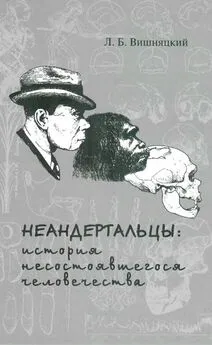Леонид Вишняцкий - Неандертальцы какими они были, и почему их не стало
- Название:Неандертальцы какими они были, и почему их не стало
- Автор:
- Жанр:
- Издательство:Stratum plus
- Год:2010
- ISBN:нет данных
- Рейтинг:
- Избранное:Добавить в избранное
-
Отзывы:
-
Ваша оценка:
Леонид Вишняцкий - Неандертальцы какими они были, и почему их не стало краткое содержание
Эта небольшая книжка посвящена неандертальцам - самым близким родственникам гомо сапиенс среди всех существ, когда-либо обитавших на нашей планете. Ни об одном другом виде ископаемых гоминид мы не знаем сегодня столько, сколько о них. Автор рассказывает об их анатомии, генетике, эволюционной истории, о разных сторонах их культуры. Особое внимание уделено вопросу об интеллектуальном потенциале неандертальцев, проблеме их гибридизации с гомо сапиенс, а также причинам их исчезновения.
Неандертальцы какими они были, и почему их не стало - читать онлайн бесплатно полную версию (весь текст целиком)
Интервал:
Закладка:
Fedele F. G., B. Giaccio, I. Hajdas. 2008. Timescales and cultural process at 40,000 BP in the light of the Campanian ignimbrite eruption, Western Eurasia. Journal of Human Evolution 55, 834-857.
Fernandez S., N. Fuentes, J. S. Carrion, P. Gonzalez- Samperiz, E. Montoya, G. Gil, G. Vega-Toscano, J. A. Riquelme. 2007. The Holocene and Upper Pleistocene pollen sequence of Carihuela Cave, southern Spain. Geobios 40, 75-90.
Finlayson C. 2004. Neanderthals and modern humans. Cambridge: Cambridge University Press.
Finlayson C. 2009. The humans who went extinct: why Neanderthals died out and we survived. New York: Oxford University Press.
Finlayson C., F. G. Pacheco, J. Rodriguez-Vidal, D. A. Fa, J. M. G. Lopez, A. S. Perez. 2006. Late survival of Neanderthals at the southernmost extreme of Europe. Nature 443, 850-853.
Froehle A. W. and S. E. Churchill. 2009. Energetic competition between Neandertals and anatomically modern humans. PaleoAnthropology, 96-116.
Gaudzinski S., E. Turner, A. P. Anzidei, E. Alvarez- Fernandez, J. Arroyo-Cabrales, J. Cinq-Mars,
T. Dobosi, A. Hannus, E. Johnson, S. C. Munzel, A. Scheer, P. Villa. 2005. The use of Proboscidean remains in every-day Palaeolithic life. Quaternary International 126-128, 179-194.
Gowlett J. A. J. 2006. The early settlement of northern Europe: Fire history in the context of climate change and the social brain. Comptes Rendus Palevol 5, 299-310.
Green R.E., J. Krause, S.E. Ptak, A.W. Briggs, M.T. Ronan, J.F. Simons, L. Du, M. Egholm, J.M. Rothberg, M. Paunovic, S. Paabo. 2006. Analysis of one million base pairs of Neanderthal DNA. Nature 444, 330336.
Green R. E., A.-S. Malaspinas, J. Krause, A. W. Briggs, P. L. F. Johnson, C. Uhler, M. Meyer, J. M. Good, T. Maricic, U. Stenzel, K. Prufer, M. Siebauer,
A. Burbano, M. Ronan, J. M. Rothberg,
M.Egholm, P. Rudan, D. Brajkovic, Z. Kucan,
Gusic, M. Wikstrom, L. Laakkonen, J. Kelso, M. Slatkin, S. Paabo. 2008. A complete Neandertal
Литература
mitochondrial genome sequence determined by high-throughput sequencing. Cell 134, 416-426.
Grimaud-Herve D. 1997. L'Evolution de l'encephale chez Homo erectus et Homo sapiens. Cahiers de Paleoanthropologie. Paris: CNRS.
Grunberg J.M. 2002. Middle Paleolithic birch-bark pitch. Antiquity 76, 15-16.
Guatelli-Steinberg D. 2009. Recent studies of dental development in Neandertals: Implications for Neandertal life histories. Evolutionary Anthropology 18, 9-20.
Hambucken A. 1997. La variabilite geographique des Neandertaliens. Anthropologica et Praehistorica 108, 109-120.
Harris J. R. 2006. Parental selection: A third selection process in the evolution of human hairlessness and skin color. Medical Hypotheses 66, 1053-1059.
Harvati K. 2007. Neanderthals and their contemporaries // In: Henke W. and I. Tattersall (eds.). Handbook of Paleoanthropology, vol. 3. Berlin, Heidelberg, New York: Springer, 1717-1748.
Hawks J. and G. Cochran. 2006. Dynamics of adaptive introgression from archaic to modern humans. PaleoAnthropology, 101-115.
Hebsgaard M. B., C. Wiuf, M. Thomas, P. Gilbert, H. Glenner,
Willerslev. 2007. Evaluating neanderthal genetics and phylogeny. Journal of Molecular Evolution 64: 50-60.
Henry and Piperno. 2008. Plants in Neanderthal diet: Plant microfossil evidence from the dental calculus of Shanidar III (Paper presented to the Paleoanthropology Society annual meeting, Vanqouver, 25-26 March 2008).
Higham T. 2006. Revised direct radiocarbon dating of the Vindija G1 Upper Paleolithic neandertals. Proceedings of the National Academy of Sciences of the USA 103, 553-557.
Hockett B. and J. A. Haws. 2005. Nutritional ecology and the human demography of Neandertal extinction. Quaternary International 137, 21-34.
Hofreiter M. and J. Stewart. 2009. Ecological change, range fluctuations and population dynamics during the Pleistocene. Current Biology 19, R584-R594.
Holloway R. L. 1985. The poor brain of Homo sapiens neanderthalensis: see what you please... In: Delson E. (ed.). Ancestors: The hard evidence. New York: Alan R. Liss, 319-324.
Holloway R. L., D. C. Broadfield, M. S. Yuan. 2004. Brain endocasts: The paleoneurological evidence. (The Human fossil record, vol. III). Hoboken, N.J.: Wiley & Sons.
Holloway R. L. 2009. Brain fossils: Endocasts. In: Squire L.R. (ed.). Encyclopedia of Neuroscience, vol. 2. Oxford: Academic Press, 353-361.
Holton N. E. and R. G. Franciscus. 2008. The paradox of a wide nasal aperture in cold adapted Neandertals: a casual assessment. Journal of Human Evolution 55, 942-951.
Hublin J.-J. 1998. Climatic changes, paleogeography and the evolution of Neanderthals. In: Akazawa T., K. Aoki, O. Bar-Yosef (eds.). Neanderthals and modern humans in Western Asia. New York: Plenum Press, 295-310.
Hublin J.-J. 2006. Neandertal as another humankind: where are we now? Terra Nostra (2): 55-59.
Hublin J.-J. 2009. The origin of Neandertals. Proceedings of the National Academy of Sciences of the USA 106, 16022-16027.
Hublin J.J. and S.E. Bailey. 2006. Revisiting the last Neandetals. In: Conard N.J. (ed.). When Neanderthals and Modern Humans Met. Tubingen: Kerns Verlag, 105-128.
Huxley T. H. 1864. Further remarks upon the human remains from the Neanderthal. Natural History Review 1, 429-446.
Kittler R. et al. 2003. Molecular evolution of Pediculus humanus and the origin of clothing. Current Biology 13, 1414-1417.
Klein R. G. 1989. The Human Career. Human Biological and Cultural Origins. Chicago and London: University of Chicago Press. [2nd ed. 1999; 3rd ed. 2009].
Koller J. and D. Mania. 2001. High-tech in the Middle Paleolithic:Neanderthal-manufactured pitch
identified. European Journal of Archaeology 4, 385-397.
Krause J., C. Lalueza-Fox, L. Orlando, W. Enard, R. Green et al. 2007a. The derived FOXP2 variant of modern humans was shared with Neandertals. Current Biology 17, 1-5.
Lalueza-Fox C. 2006. Mitochondrial DNA of an Iberian Neandertal suggests a population affinity with other European Neandertals. Current Biology 16, 629-630. Lalueza-Fox C., H. Rompler, D. Caramelli, C. Staubert,
Catalano, D. Hughes, N. Rohland, E. Pilli,
Longo, S. Condemi, M. de la Rasilla, J. Fortea, A. Rosas, M. Stoneking, T. Schoneberg,
Bertranpetit, M. Hofreiter. 2007. A melanocortin 1 receptor allele suggests varying pigmentation among Neanderthals. Science 318, 1453-1455.
Lee S.-H. and M. Wolpoff. 2003. The pattern of evolution in Pleistocene human brain size. Paleobiology 29, 186-196.
Lewin R. and R. A. Foley. 2004. Principles ofhuman evolution.
2nd ed. Malden/Oxford/Carlton: Blackwell. Lieberman P. and E. S. Crelin. 1971. On the speech of Neandertal man. Linguistic Inquiry 2, 203-222.
Liu H., F. Prugnolle, A. Manica, F. Balloux. 2006. A geographically explicit genetic model of worldwide human-settlement history. American Journal of Human Genetics 79, 230-237.
Macaulay V., C. Hill, A. Achilli, C. Rengo, D. Clarke,
W.Meehan, J. Blackburn, O. Semino, R. Scozzari,
Cruciani, A. Taha, N.K. Shaari, J.M. Raja, P. Ismail, Z. Zainuddin, W. Goodwin, D. Bulbeck,
-J. Bandelt, S. Oppenheimer, A. Torroni,
M.Richards. 2005. Single, rapid coastal settlement of Asia revealed by analysis of complete mitochondrial genomes. Science 308, 1034-1036.
MacLarnon A. M. and G. P. Hewitt. 1999. The evolution of human speach: the role of enhanced breathing control. American Journal of Physical Anthropology 109, 341-363.
McDougall I., F. H. Brown, J. G. Fleagle. 2008. Sapropels and the age of hominins Omo I and II, Kibish, Ethiopia. Journal of Human Evolution 55, 409-420.
Martinez I., M. Rosa, J.-L. Arsuaga et al. 2004. Auditory capacities in Middle Pleistocene humans from the Sierra de Atapuerca in Spain. Proceedings of the National Academy of Sciences of the USA 101, 9976-9981.
Martinez I., J. L. Arsuaga, R. Quam, J. M. Carretero, A. Gracia, L. Rodriguez. 2008. Human hyoid bones from the Middle Pleistocene site of Sima de los Huesos (Sierra de Atapuerca, Spain). Journal of Human Evolution 54, 118-124.
Mazza P. P. A., F. Martini, B. Sala, M. Magi, M. P. Colombini,
Giachi, F. Landucci, C. Lemorini, F. Modugno, E. Ribechini. 2006. A new Palaeolithic discovery: tar-hafted stone tools in a European Mid-Pleistocene bone-bearing bed. Journal of Archaeological Science
Литература
33, 1310-1318.
Mellars P. 1996. The Neanderthal Legacy. An Archaeological Perspective from Western Europe. Princeton: Princeton University Press.
Mithen S. 1996. The Prehistory of the Mind. London: Thames and Hudson.
Mithen S. 2007. General intellectual ability. In: Gangestad S.W. and J.A. Simpson (eds.). The Evolution of Mind: Fundamental Questions and Controversies. New York and London: The Guilford Press, 319-324.
Noonan J. P., G. Coop, S. Kudaravalli, D. Smith, J. Krause, J. Alessi, F. Chen, D. Platt, S. Paabo, J. K. Pritchard, E. M. Rubin. 2006. Sequencing and analysis of Neanderthal genomic DNA. Science 314, 11131118.
Onac B. P., I. Viehmann, J. Lundberg, S.-E. Lauritzen, C. Stringer, V. Popita. 2005. U-Th ages constraining the Neanderthal footprint at Vartop Cave, Romania. Quaternary Science Reviews 24, 1151-1157.
Orlando L., P. Darlu, M. Toussaint, D. Bonjean, M. Otte, C. Hanni. 2006. Revisiting Neandertal diversity with a 100,000 year old mtDNA sequence. Current Biology 16, 400-402.
Orschiedt J. 2008. Der Fall Krapina — neue Ergebnisse zur Frage van Kannibalismus beim Neandertaler. Quartar 55, 63-81.
Pearson O. M. 2004. Has the combination of genetic and fossil evidence solved the riddle of modern human origins. Evolutionary Anthropology 13, 145-159.
Ponce de Leon M. S., L. Golovanova, V. Doronichev, G. Romanova, T. Akazawa, O. Kondo, H. Ishida, C. P. E. Zollikofer. 2008. Neanderthal brain size at birth provides insights into the evolution of human life history. Proceedings of the National Academy of Sciences of the USA 16, 13764-13768.
Rampino M. R. and S. Self. 1992. Volcanic winter and accelerated glaciation following the Toba supereruption. Nature 359, 50-52.
Richards M., K. Harvati, V. Grimes, C. Smith, T. Smith, J.-J. Hublin, P. Karkanas, E. Panagopoulou. 2008. Strontium isotope evidence of Neanderthal mobility at the site of Lakonis, Greece using laser-ablation PIMMS. Journal of Human Evolution 35, 12511256.
Rogers A. R., D. Iltis, S. Wooding. 2004. Genetic variation at the MC1R locus and the time since loss of human body hair. Current Anthropology 45,105-108.
Rolland N. 2004. Was the emergence of home bases and domestic fire a punctuated event? A review of the Middle Pleistocene record in Eurasia. Asian Perspectives 43, 248-280.
Rosas A., M. Bastir, C. Martinez-Maza, A. Garcia-Tabernero, C. Lalueza-Fox. 2006. Inquiries into Neanderthal craniofacial development and evolution: "accretion" versus “organismic" models. In: Harvati K. and T. Harrison (eds.). Neanderthals Revisited: New Approaches and Perspectives. Dordrecht: Springer, 37-69.
Royer D. F., C. A. Lockwood, J. E. Scott, F. E. Grine. 2009. Size variation in early human mandibles and molars from Klasies River, South Africa: Comparison with other Middle and Late Pleistocene assemblages and with modern humans. American Journal of Physical Anthropology 140, 312-323.
Rushton J. P. 1997. Race, Evolution, and Behavior: A Life History Perspective. 2nd ed. New Brunswick, NJ: Transaction Publishers.
Sawyer G. J. and B. Maley. 2005. Neanderthal reconstructed. The Anatomical Record 283B, 23-31.
Schmitz R. W. 2006. The discovery of fossil man in the 1841 and 19th century. In: Schmitz R.W. (ed.). Neanderthal 1856-2006. Mainz am Rhein: Verlag Philipp von Zaibern, 9-16.
Читать дальшеИнтервал:
Закладка:






